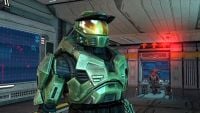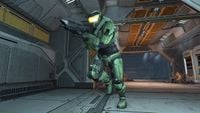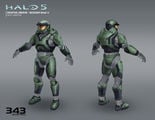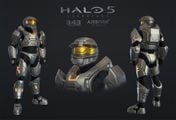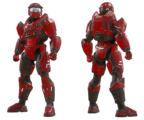MJOLNIR Powered Assault Armor/Mark V: Difference between revisions
From Halopedia, the Halo wiki
RadiculousJ (talk | contribs) m (→Known variants: Added Mark V Delta) |
RadiculousJ (talk | contribs) m (→Known variants: Link correction.) |
||
| Line 35: | Line 35: | ||
====Known variants==== | ====Known variants==== | ||
Variants compatible with the Mark V include, but are not necessarily limited to: | Variants compatible with the Mark V include, but are not necessarily limited to: | ||
*'''[[AIR_ASSAULT-class_Mjolnir|MJOLNIR/AA]]''' - | *'''[[AIR_ASSAULT-class_Mjolnir|MJOLNIR/AA]]''' - Air Assault - Developed as a part of a project to improve the ODST helmet and issued to [[UNSC Army airborne|Army airborne]] units. | ||
*'''[[B-class_Mjolnir|MJOLNIR/B]]''' - B-class - Privately manufactured initial production model of the Mark V set; the helmet is issued exclusively to [[Special Warfare Command|SPECWARCOM]] [[Special Warfare Group Three|Group Three]]. | *'''[[B-class_Mjolnir|MJOLNIR/B]]''' - B-class - Privately manufactured initial production model of the Mark V set; the helmet is issued exclusively to [[UNSC Special Forces#Unified Special Warfare Command|SPECWARCOM]] [[Special Warfare Group Three|Group Three]]. | ||
*'''[[CQB-class_Mjolnir|MJOLNIR/C]]''' - CQB - A more advanced close-quarters combat variant. | *'''[[CQB-class_Mjolnir|MJOLNIR/C]]''' - CQB - A more advanced close-quarters combat variant. | ||
*'''[[CQC-class_Mjolnir|MJOLNIR/CQC]]''' - CQC - Designed for close-quarters combat. Precursor of the MJOLNIR/C CQB variant. | *'''[[CQC-class_Mjolnir|MJOLNIR/CQC]]''' - CQC - Designed for close-quarters combat. Precursor of the MJOLNIR/C CQB variant. | ||
*'''[[EOD-class_Mjolnir|MJOLNIR/EOD]]''' - EOD - A variant designed for [[wikipedia:Bomb disposal|explosive ordnance disposal]]. | *'''[[EOD-class_Mjolnir|MJOLNIR/EOD]]''' - EOD - A variant designed for [[wikipedia:Bomb disposal#EOD|explosive ordnance disposal]]. | ||
*'''[[FJ/PARA-class_Mjolnir|MJOLNIR/FJ/PARA]]''' - FJ/Para - A lightweight variant for airborne units. | *'''[[FJ/PARA-class_Mjolnir|MJOLNIR/FJ/PARA]]''' - FJ/Para - A lightweight variant for airborne units. | ||
*'''[[GRENADIER-class_Mjolnir|MJOLNIR/G]]''' - Grenadier - This G variant is an up-armored prototype based on the basic Mk.IV helmet. | *'''[[GRENADIER-class_Mjolnir|MJOLNIR/G]]''' - Grenadier - This G variant is an up-armored prototype based on the basic Mk.IV helmet. | ||
*'''[[GUNGNIR-class Mjolnir|MJOLNIR/G]]''' - GUNGNIR - This G variant was developed for Mark V as part of [[Project GUNGNIR]] alongside the [[M6 Grindell/Galilean Nonlinear Rifle]]. | *'''[[GUNGNIR-class Mjolnir|MJOLNIR/G]]''' - GUNGNIR - This G variant was developed for Mark V as part of [[Project GUNGNIR]] alongside the [[M6 Spartan Laser|M6 Grindell/Galilean Nonlinear Rifle]]. | ||
*'''[[HAZOP-class_Mjolnir|MJOLNIR/HAZOP]]''' - HAZOP - A variant for missions considered too hazardous for standard equipment. | *'''[[HAZOP-class_Mjolnir|MJOLNIR/HAZOP]]''' - HAZOP - A variant for missions considered too hazardous for standard equipment. | ||
*'''[[COMMANDO-class_Mjolnir|MJOLNIR/K]]''' - Commando - Developed to improve a Spartan's tactical awareness on the battlefield.<ref>'''Halo: The Essential Visual Guide''', ''page 33''</ref> | *'''[[COMMANDO-class_Mjolnir|MJOLNIR/K]]''' - Commando - Developed to improve a Spartan's tactical awareness on the battlefield.<ref>'''Halo: The Essential Visual Guide''', ''page 33''</ref> | ||
*'''[[SECURITY-class_Mjolnir|MJOLNIR/M]]''' - Security - Privately manufactured variant designed for security personnel. | *'''[[SECURITY-class_Mjolnir|MJOLNIR/M]]''' - Security - Privately manufactured variant designed for security personnel. | ||
*'''[[ | *'''[[MP-class Mjolnir|MJOLNIR/MP]]''' - Military Police - A variant of the standard-issue [[CH252 helmet]]. A shared asset among all branches of the [[UNSC Armed Forces]], primarily [[Beta-5 Division|Beta-5]] [[military police]]. | ||
*'''[[ODST armor|MJOLNIR/ODST]]''' - The Mark V is compatible with several parts of the ODST armor, including the helmet, chest-piece, and shoulder pauldrons. | *'''[[ODST armor|MJOLNIR/ODST]]''' - The Mark V is compatible with several parts of the ODST armor, including the helmet, chest-piece, and shoulder pauldrons. | ||
*'''[[OPERATOR-class_Mjolnir|MJOLNIR/Operator]]''' - Operator - Variant for the ONI's Beta-5 Asymmetrical Action Group. | *'''[[OPERATOR-class_Mjolnir|MJOLNIR/Operator]]''' - Operator - Variant for the ONI's Beta-5 Asymmetrical Action Group. | ||
Revision as of 04:32, December 8, 2016
| MJOLNIR Powered Assault Armor/Mark V | |
|---|---|
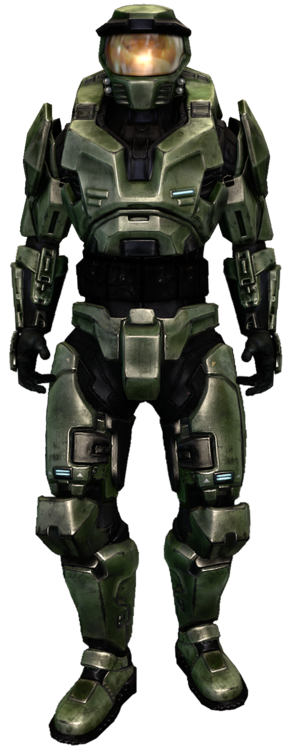
| |
| Production overview | |
|
Manufacturer(s): |
|
|
Testing site(s): |
|
|
Type: |
|
|
Role(s): |
General combat |
| Technical specifications | |
|
Feature(s): |
Energy shielding |
- "This—is everything I had always dreamed it could be."
- — Dr. Catherine Halsey
The MJOLNIR Powered Assault Armor/Mark V was the second major version of the MJOLNIR Powered Assault Armor series. The initial version of the Mark V powered exoskeleton, designated as Mark V[B],[1] was issued to the SPARTAN-IIs and several SPARTAN-III commandos on November 24, 2551,[2] while the second version of the armor was unveiled for Operation: RED FLAG on August 29, 2552.[3][4][note 1] The Mark V armor was in service until October 2552, when it was replaced by the MJOLNIR Mark VI.[5] It could still be requisitioned by SPARTAN-IV personnel as late as October 2558, albeit upgraded to function with the MJOLNIR [GEN2] suite.[6][7]
Development history and design
In 2542, seventeen years after the MJOLNIR Mark IV entered service, production began on the next generation of MJOLNIR armor. A team under the leadership of Chief Scientist Dr. Catherine Halsey would spend the next ten years developing the suit. Using data collected from the Mark IV, hundreds of minor technical improvements, and several major changes, were made to the Mark V; most notably, the suit's armor plating underwent a total redesign and better materials were developed for its use. Separating the Mark V from the previous version of the system were two major breakthroughs in the ways in which the suit improves its wearer's combat effectiveness.[4]
The first major breakthrough, which was introduced with the first generation of the Mark V, was the addition of a self-recharging energy shield system, reverse-engineered from captured Kig-yar point defense gauntlets,[8] which repel objects and energy bursts, plus any other hazardous elemental energies. While impacts on the shield place a substantial drain on the system's power supply, the system's energy regenerates once the user is no longer under fire. However, the adaptation of the shield covering the entire body weakens the magnetic field, making the Mark V's shield system vulnerable to sustained fire. Energy shield technology was first tested on the Mark IV, though such tests were not especially successful.[9][3]
The second major advancement, which was not implemented until the second generation of the suit,[3][4] was the addition of a layer of computer memory superconductor that would allow an artificial intelligence to piggyback into the field with the operator to both provide and gather real-time intelligence. The synthesis of an artificial intelligence with a human brain is not possible without an upgrade to the user's already-specialized neural interface. Like the standard neural interface, the specialized neural lace translates electrochemical signals to digital code and routes them through an interface connection at the rear of the skull. Through this interface, the user's thoughts command the armor's movement and weapons, and input from the on-board sensors is fed directly to the user's mind. In addition, an AI personality and processing matrix can be carried by the armor and delivered to the suit via the specialized neural lace and on-board storage in a crystal data chip no larger than a personal credit card. Without the armor, a Spartan's reaction time is charted at twenty milliseconds; with the Mark V, and a AI on-board, the time required to translate thought into motion is rendered almost instantaneous.
The suit also possesses other upgraded features that enhance its wearer's abilities. It has an upgraded heads-up display linked to sensors that project shield strength and an improved motion detecting system in addition to providing other numerous readouts, including allies' vitality and shield status. These features are maintained and initialized by the Mark V BIOS firmware.
In its second phase, the Mark V MJOLNIR battle armor weighs a quarter ton (226,8 kilograms), and with its SPARTAN wearer. The SPARTAN/MJOLNIR combination is designed to be the most devastating intelligence tool ever created, as the AI can greatly increase the wearer's reaction time and vastly improve intelligence gathering capacity.
John-117 was the first Spartan to test the second-generation MJOLNIR Mark V with a smart AI implemented within the armor during a "live-fire" combat scenario.[3] His test was to ring a bell after going through an obstacle course. This course involved ten Orbital Drop Shock Troopers, a minefield with Lotus anti-tank mines, three automated 30mm chain guns, a forest of wooden poles, and an unexpected SkyHawk jumpjet utilizing four 50mm cannons and Scorpion missiles. This test showed that an AI could vastly improve the armor's reaction times.[10]
After the Human-Covenant War, the Mark V MJOLNIR components were adapted for the use of the SPARTAN-IV in the MJOLNIR (GEN2) armor. The GEN2 variant of the Mark V was tested at the Damascus Testing Facility in Vhalkem on Chi Ceti IV, a significant MJOLNIR development site for several decades.[11]
Armor variants
GEN1
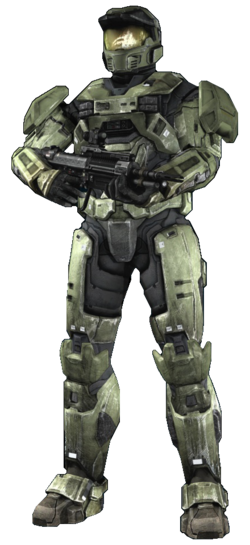
A large number of variants of the Mark V were manufactured for use in the field. In addition, the armor system is compatible with components and variants created for the earlier or later MJOLNIR generations.
Known variants
Variants compatible with the Mark V include, but are not necessarily limited to:
- MJOLNIR/AA - Air Assault - Developed as a part of a project to improve the ODST helmet and issued to Army airborne units.
- MJOLNIR/B - B-class - Privately manufactured initial production model of the Mark V set; the helmet is issued exclusively to SPECWARCOM Group Three.
- MJOLNIR/C - CQB - A more advanced close-quarters combat variant.
- MJOLNIR/CQC - CQC - Designed for close-quarters combat. Precursor of the MJOLNIR/C CQB variant.
- MJOLNIR/EOD - EOD - A variant designed for explosive ordnance disposal.
- MJOLNIR/FJ/PARA - FJ/Para - A lightweight variant for airborne units.
- MJOLNIR/G - Grenadier - This G variant is an up-armored prototype based on the basic Mk.IV helmet.
- MJOLNIR/G - GUNGNIR - This G variant was developed for Mark V as part of Project GUNGNIR alongside the M6 Grindell/Galilean Nonlinear Rifle.
- MJOLNIR/HAZOP - HAZOP - A variant for missions considered too hazardous for standard equipment.
- MJOLNIR/K - Commando - Developed to improve a Spartan's tactical awareness on the battlefield.[12]
- MJOLNIR/M - Security - Privately manufactured variant designed for security personnel.
- MJOLNIR/MP - Military Police - A variant of the standard-issue CH252 helmet. A shared asset among all branches of the UNSC Armed Forces, primarily Beta-5 military police.
- MJOLNIR/ODST - The Mark V is compatible with several parts of the ODST armor, including the helmet, chest-piece, and shoulder pauldrons.
- MJOLNIR/Operator - Operator - Variant for the ONI's Beta-5 Asymmetrical Action Group.
- MJOLNIR/Pilot - Pilot - A variant developed for use by the UNSC Air Force that was adapted for compatibility with the Mark V.
- MJOLNIR/R - Recon - A variant specialized for reconnaissance missions, developed parallel to the S variant.
- MJOLNIR/S - Scout - A variant with limited stealth capabilities, developed parallel to the R variant.
- MJOLNIR/V - EVA - Variant that specialized to improve survivability of Spartans when performing extra-vehicular activity in vacuum.
Mark VI prototype
In 2552 prior to the Fall of Reach a Mark VI helmet was tested on Mark V armor alongside the Recon armor set.
Supplemental armor and accessories
- Assault - For close to medium distance combat.
- Collar - Armor that covers the back of the neck.
- HP (Hard Point) - Additional armor plating and hard points for missions involving High-Altitude Low Opening jumps.
- Jump Jet - Safety restraints for use with a jetpack.
- Sniper - Shoulder armor attachment designed for carrying sniper rifle ammunition.
- Tactical - Various pouches, webbing and electronics accessories.
- UA (Up-Armor) - Supplemental armor attachments.
Attachments
- External Command Network Module - CNM
- CBRN Hardened Uplink Module - CBRN/HUL
- External Hardened Uplink - HUL
Mark VI upgrade
In late 2552, all surviving Mark V helmets received an upgrade with then current-issue internal components and software Mark VI.
GEN2
As of 2558, the Mark V has been upgraded to function with the MJOLNIR [GEN2] suite.
Known variants
- Hybrid GEN2/Mark V [Gen 1]
This variant is largely based off the GEN1 variant but with heavily modified components to meet the standards of GEN2 armor. Some contemporary Spartan-IVs use this armor in 2558. [13]
- H4-MJOLNIR-MkV-Armor.png
- Mark V Alpha
The Mark V Alpha is a highly configurable version of the original Mark V armor. Though it is unclear who requested an integration check for the Mark V helmet with the latest GEN2 architecture, engineers at Materials Group have been surprised at the MARK V ALPHA's near-parity with contemporary designs.[14]
- Mark V Delta
Upgrades
Various upgrades were also designed along with the standard Mark V, in ONI's CASTLE Base on Reach to aid certain Spartans' abilities in combat. The following is a list of known upgrade components and variants:
- Neural induction circuits - Allowed the armor to respond to the wearer's movement at a faster rate.[15]
- Linear accelerator - Doubles the strength of the energy shield system and allows the MJOLNIR to take more hits before failing.[15]
- Image enhancing computer - Better visual display on the MJOLNIR's heads-up display.[15]
- Improved tracking system - Better tracking system on the MJOLNIR'S heads-up display, which improved accuracy at distances up to a thousand meters.[15]
- Improved motion sensors - Improves sensitivity readings on the motion tracker allowing for more accurate readings.[15]
In addition, the Mark V armor supports different types of additional attachments, which enable various abilities. Some of these may be related to the add-ons described above. The armor is also compatible with various types of propulsion equipment, such as thruster packs and portable jump-jets.
- Armor lock - A compact generator device on the back of the user generates a powerful shield, whilst simultaneously engaging the suit's lockdown system. This offers temporary near-invulnerability to all ground weaponry and sends out an electromagnetic pulse once the lockdown is disengaged.
- Active camouflage emitter - The active camouflage plug-in can make the user nearly invisible for brief periods of time. As a drawback, the more the user moves, the more visible he/she becomes. In addition, all sound is muffled to the user while the camo is engaged, and the motion sensor is rendered virtually inoperative.
- Hologram module - A device on the back of the armor allows a hologram to be sent out to draw enemy fire.
- Sprint module - A module that bypasses the safety limiters of the suit's actuators and "muscles", allowing better performance at the expense of heat regulation, overheating and fatiguing the user if used for prolonged periods.
Armor components
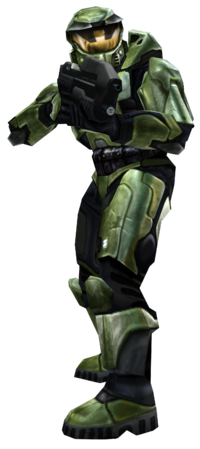
- Helmet: The helmet is one of the most crucial aspects of the MJOLNIR system. It is made of titanium and contains key features like a heads-up display that links to the brain and hands, and can identify equipment and display information about it when it is picked up by the wearer. Another feature is the direct neural interface system which connects to the wearer's neural implants. Two core processor chips are implanted into the subjects skull in the rear of the head. This is essentially comparable to an on board computer using parts of the human brain for processing, when the connector at the rear of the subjects head and receptors in the brain link to the helmets onboard sensors it creates the neural link needed to move the MJOLNIR suit. The helmet also contains other equipment to protect and aid the user in hostile conditions. This includes filters to remove toxins from the atmosphere, a supply to provide air to the wearer during EVA, thermal and motion sensors, communications, solar-powered lighting, and imaging and video gear. The helmet also contains the AI housing, where a ship-borne AI chip can be inserted, located on the back of the helmet. The Mark V helmet is an upgraded version of the Mark IV helmet, modified to function with the Mark V's energy shield systems,[16] though, like the rest of the Mark V system, it likely incorporates several other changes as well. The helmet supports various external upgrades, such as a Command Network Module and Up-Armor plating.
- Titanium alloy outer shell: The outer shell of the MJOLNIR armor is comprised of a fairly thick titanium alloy. This plating covers the chest, arms, hip, legs, calves, feet and hands. This alloy is very resilient, can take significant punishment, and is nearly impervious to small arms fire. While enough shots from armor piercing rounds will breach the outer shell, the suit can take a few glancing blows from them without compromising the armor. The outer shell of all the MJOLNIR suits is covered with a refractive coating to help disperse the heat experienced from Covenant energy weapons. However one or two direct hits from any Plasma weapon will compromise the armor plating.
- Titanium nanocomposite bodysuit: Sandwiched between the external armor and the internal padding is a thick black armored bodysuit. This suit has numerous functions, small but vital to the safety and survival of the wearer. The bodysuit is made of a titanium-based material, making it very strong and yet very flexible. It also serves as another layer of protection against ballistics attacks and is coated with a heat resistant material to disperse heat from plasma weapons.
- Hydrostatic gel layer: Underneath the armored bodysuit is a gel-filled layer, this gel layer regulates the temperature of the suit and can reactively change its density to conform to the wearer's shape, the temperature inside the suit is controlled by the moisture absorbing cloth suit underneath the hydrostatic layer. The hydrostatic gel layer can also be pressurized to various levels to potentially save the wearers life should the wearer be subjected to high G forces or a high velocity impact; however, over pressurizing this layer can cause nitrogen embolisms.[17][18]
- Reactive crystal layer: Sandwiched between the external armor and the internal padding is a layer of piezoelectric material that deforms along a preferred axis when exposed to a electric charge. When creating the suit, the liquid crystal material is poured into a capillary system where electric charges can direct the formation of crystal geometries.[19] This layer acts as synthetic muscle, allowing the Spartan access to approximately twice their normal strength. This is not due to a "Leverage Effect," but rather that a human-sized suit will provide about six hundred kilos of lifting power, in addition to an average Spartan's six hundred kilos of lifting power. Assuming a Spartan has an average body weight of 200 kilos, and that CPO Mendez's assertion that: "They can lift three times their body weight- which, I might add, is almost double the norm due to their increased muscle density," is indeed accurate.[20]
- Memory-processor superconductor layer: A layer relatively new to the MJOLNIR line, introduced with the Mark V, that is capable of housing an A.I. Comprised of the same material as a starship's A.I. system, this layer allows an A.I. to travel with a soldier into the field. The A.I. can then aid the soldier in software inrtusion, hardware hacking, and espionage by listening to enemy chatter.[21] As a side note, this layer is often confused with the Reactive Metal Liquid Crystal layer, which due to the latter's piezoelectric properties is impossible.
- Magnetic weapon holder strips: The MJOLNIR armor features very small, yet powerful magnets placed on the legs, waist, and back of the suit that are used to hold any equipment or any weapons with a magnetic property. The suit also contains a magnet system within its boots that allows its wearer to stay attached to a metal surface in zero G environments and can be toggled on or off by the wearer.
- Energy shields: First used on the Mark V, and later refined on the Mark VI, the energy shield device is reverse engineered from Covenant technology. Beginning in 2532[22] forty scientists and technicians would spend the next twenty years attempting to make some use of the technology. For decades the attempts at cracking their technology had met with failure after failure; some had given up and others in the scientific community believed the energy shield technology could never be cracked. However at some point before 2552 a breakthrough was made and for the first time the UNSC had successfully cracked and improved upon the technology.[23]
- Pressure seal: The pressure seal is a vital component to the MJOLNIR system; it keeps the system airtight underwater or in space. The seal is very strong, only breaking under extreme pressure, such as in a high velocity impact or when the hydrostatic gel has been overpressurized.
- Automatic biofoam injectors: Biofoam injectors are an integral component of the systems that keep a SPARTAN-II functioning in battle even after injuries which would otherwise incapacitate the wearer.[24][note 2] Biofoam is a medical gel that is used to fill and seal a wound automatically as well as to treat any infection that could occur as a result of the wound.
- Biofoam injection ports: The Mark V armor possesses injection ports where a direct supply of biofoam or other medicines can be administered from a standard military first aid kit when the wearer is injured.[25]
- Fusion reactor: The fusion reactor is the most essential part of the MJOLNIR system, as it provides power to all equipment used by the armor, the reactor is built into the suit and allows for nearly unlimited movement. The fusion reactor in all versions of the MJOLNIR armor are half the size of a normal fusion pack that conventional marines carry around.[26]
- Force-multiplying circuits: Located throughout the armor, these systems boost the force applied by the user. They make hand-to-hand combat easier, but also make the armor difficult to adjust to; a slight motion can be translated into a potentially harmful one if not conducted correctly. For this reason it is only possible for Spartans to use this armor, as their strengthened bodies are able to withstand the increased power and speed of movement, which, in unaugmented human bodies, results in broken bones or death due to spasms caused by the pain of broken bones.
- Reactive circuits: Reactive circuits are systems directly linked into the wearer's neural interface. They amplify the wearer's reaction time by connecting directly to the thoughts of the wearer, making it much easier to control and allowing for the soldier to be both more efficient and have a higher survival rate in combat.
- Power supply control unit: The power supply control unit controls the power supply of the armor.
- MJOLNIR Mark V BIOS: The basic input/output system, standard firmware interface for the Mark V.
- Lock-down system: The lock-down system protects muscles and joints from traumatic, high-impact injuries by seizing the suit into a rigid posture through modifying the density of the hydrostatic gel layer.[27][28][29][30]
- Fail-safe detonation system - This system functions as a self-destruct mechanism in order to prevent a dead Spartan's armor from being compromised by hostiles. It is activated by a series of digits that only the Spartans know. When engaged, it produces a reactor overload that burns everything within a ten-meter radius, then produces a large blast.[31]
Performance and durability
The Mark V armor was a major upgrade from the previous version of MJOLNIR armor. With the inclusion of energy shielding, this iteration of MJOLNIR is extremely resistant to not just gunfire and explosions, but plasma weaponry as well. While John-117 was field testing Mark V MJOLNIR on Reach in 2552, his armor's shields were not only able to take the hits from multiple 30mm chain guns, but it was also able to withstand the blast from a Scorpion missile.[32]
During the Fall of Reach, the Mark V armor worn by the Spartan IIs of Red team was able sustain the lives of most them and even keep functioning after hitting the ground at terminal velocity.[33]
During the Battle of Installation 04, John-117's Mark V armor was able to withstand the "wash" from an off-target plasma bolt from a Mgalekgolo's assault cannon.[34]
 This section needs expansion. You can help Halopedia by expanding it.
This section needs expansion. You can help Halopedia by expanding it.
In-game armor permutations
Halo 3
The second version of the Mark V Helmet is the only part of the armor available to the player, it is unlocked by getting the UNSC Spartan achievement.
- Description: Originally issued in August 2542, all extant Mark V helmets have been upgraded with current-issue internal components and software.
Halo: Reach
The first version of the Mark V helmet and shoulder pauldrons are available as armor permutations in Halo: Reach. The helmet is first viewable at the rank of Captain, and purchasable at Lt. Colonel.
Helmet
Issued in November 2551, this helmet is fully compatible with all current armor systems.
Base Price: 130,000 cR, Lt. Colonel
- Description: The Mk. V helmet is essentially the Mk. IV upgraded to function with MJOLNIR's new shield system.
CNM Price: 10,000 cR, Lt. Colonel
- Description: Command network module; standard issue to UNSC Special Forces unit commanders.
UA Price: 15,000 cR, Lt. Colonel
- Description: Up-armored variant of the base Mk. V pattern helmet.
Shoulders
Left Shoulder: 100,000 cR, Brigadier Right Shoulder: 80,000 cR, Brigadier
- Description: Issued in November 2551, it is compatible with all powered and semi-powered armor systems.
Halo 4
The full set of Mark V armor is available as an armor permutation in Halo 4 as part of the Infinity Armor Pack.
- Description: Favored by some Spartan-IVs due to its classic simplicity and unparalleled reputation.
Halo 5: Guardians
Mark V Alpha
Unlock: Mythic REQ card
- Armor: The Mark V and its product-improved variant, the Mark V [B], were the first Mjolnir armors to fully integrate shield emitters and sufficient computing power for an onboard Smart AI. The MARK V ALPHA is a highly configurable revamp of the original.
- Helmet: It is unclear who requested an integration check for the Mark V helmet with the latest GEN2 architecture, but engineers at Materials Group have been surprised at the MARK V ALPHA's near-parity with contemporary designs.
Available Skins: Reflex
Reflex Unlock: Mythic REQ card
Mark V Delta
Unlock: Legendary REQ card
Production notes
During the early development stages of Halo: Combat Evolved Anniversary, John-117 wore the first-generation Mark V armor seen in Halo: Reach's armor permutations,[35] though he had canonically already upgraded to the second-generation version. In the final game, he wears a second-generation suit, like he wears in the original game and in canon, which appears greatly different from the first-generation suit seen in Halo: Reach. While this conflicts with his appearance in the cryo Easter egg from Halo: Reach, his armor is not meant to be seen in any great detail in the Easter egg, making this discrepancy inconsequential.
During the development of Halo: Reach, what was to labeled as the FJ/PARA knee guards were often used as if they were standard Mark V knee guards, given the fact that the player's character was often wearing them. For unknown reasons, towards the end of the game's development cycle, these knee guards were established as a secondary type rather than the base type, which was added during this period of time. The concept art of the Mark V for Halo: Combat Evolved had the armor's knee guards being noticeably larger than the final character model's, which were reduced in size and function to being somewhat square plates of metal partially wrapping around the knee. In the context of Halo: Reach, the earlier concept art and abandoned Halo 3-era revisions closely resemble the knee guards of the Grenadier variant. However, despite any of the visual similarities, neither these concepts or their predecessors match the movement qualities of all four knee guard sets in Halo: Reach.
During the development of Halo 5: Guardians, the Mark V Alpha was codenamed "A090" when it was conceived.[36]
Gallery
- Masterchief sheik.png
Shi Kai Wang's preliminary sketch of the Master Chief in early design of MJOLNIR armor.
- SPARTAN - Mark V.jpg
Concept art of the MJOLNIR Mark V.
- SPARTAN - Mark V Helmet.jpg
Concept art of the MJOLNIR Mark V helmet.
- SPARTAN - Mark V detail.jpg
Concept studies of the MJOLNIR Mark V armor.
- Awakening.jpg
Concept art of UNSC technicians outfitting a SPARTAN-II with the Mark V.
- Mk V final.jpg
A study of the MJOLNIR Mark V armor.
Kelly-087 wearing the Mark V armor during the Battle of Onyx.
- Gallery 6889 853 280617.jpg
A redux of the MJOLNIR Mark V as seen in the Art of Halo 3.
- Ih mjolnir 1.jpg
Concept art of the base Mark V armor for Halo: Reach.
The Mark V armor, as configured in early build of Halo: Combat Evolved Anniversary.
Concept art of the Mark V Alpha for Halo 5: Guardians.
A Spartan-IV wearing the Mark V Alpha in Halo 5: Guardians.
John-117 in his Mark V in Halo Mythos.

|
Browse more images in this article's gallery page. |
List of appearances
- Halo: The Fall of Reach (First appearance)
- Halo: Combat Evolved
- Halo: The Flood
- Halo: First Strike
- Halo 2 (Various armor components)
- Halo Graphic Novel
- Halo: Ghosts of Onyx
- Halo 3
- Remember Reach
- Halo: Reach
- Halo: Fall of Reach
- Halo: Glasslands (Mentioned only)
- Halo: Combat Evolved Anniversary
- Halo 4
- Halo 2: Anniversary (Various armor components)
- Halo: Fleet Battles
- Halo 5: Guardians
- Halo Mythos: A Guide to the Story of Halo
- Halo: Fractures
Note
- ^ Halo: The Fall of Reach and Halo Waypoint's MJOLNIR Project 2 video state that the Mark V was issued on August 29, 2552. However, a number of later sources, including the aforementioned Weekly Update, Dr. Halsey's personal journal, the 2011 edition of the Halo Encyclopedia, and Halo: The Essential Visual Guide retcon this, clearly stating that the Mark V was issued on November 24, 2551. The two latter sources reveal that the suit issued in November 2551 was a prototype of the one issued in August 2552, explaining its noticeably different appearance in Halo: Reach. While John-117 indeed tested the performance of the second-generation Mark V system, ONI was actually evaluating the Spartan-AI pairing made possible by the second-generation Mark V suit.
- ^ The subsequent Mark VI generation's automatic biofoam injectors supposedly serve as the fictional explanation for the player's regenerating health in Halo 2, while the non-regenerating health in Halo: Combat Evolved and Halo: Reach seemingly suggests that the injectors were not present in the Mark V suit. However, this is merely a gameplay-related change as Halo: First Strike establishes that the Mark V was equipped with biofoam injectors.
Sources
- ^ Halo Encyclopedia, page 94 (2011 edition)
- ^ Bungie.net: Bungie Weekly Update, 1/29/10
- ^ a b c d Halo: The Essential Visual Guide, page 119
- ^ a b c Halo Encyclopedia (2011), page 97
- ^ Halo 2, campaign level The Armory
- ^ Halo 4
- ^ Halo 5: Guardians
- ^ Halo: The Fall of Reach, page ???
- ^ Dr. Halsey's personal journal
- ^ Halo: The Fall of Reach, page ???
- ^ The Halo Bulletin: 7.10.13
- ^ Halo: The Essential Visual Guide, page 33
- ^ http://worthplaying.com/article/2013/7/6/news/89850/
- ^ Halo Waypoint: Canon Fodder - Armory Amore
- ^ a b c d e Halo: First Strike, page 140
- ^ Halo: Reach, Armory
- ^ Halo: First Strike, "Chapter 2", page 13
- ^ Halo: Ghosts of Onyx, page 36
- ^ Dr. Halsey's Personal Journal, September 1, 2525
- ^ Halo: The Fall of Reach, page 92
- ^ Halo: The Fall of Reach, page 286
- ^ Halo Encyclopedia, "Chapter 3", page 89
- ^ Halo: The Fall of Reach, page 249
- ^ Halo: First Strike, page 244 (2003)
- ^ Halo: First Strike, page 123 (2003)
- ^ Halo: The Fall of Reach, page 114; page 248
- ^ Halo 3, campaign level Arrival
- ^ Halo Encyclopedia, page 91
- ^ Halo: Reach, campaign level Tip of the Spear
- ^ YouTube: Halo Reach Legendary Edition Developer Commentary Part 4
- ^ Halo: First Strike, page 315
- ^ Halo: The Fall of Reach - Definitive Edition, page 301 - 302, 304 - 305
- ^ Halo: First Strike - Definitive Edition, 22 - 24
- ^ Halo: The Flood - Definitive Edition, page 186
- ^ Halo Waypoint: BTS: Anniversary Campaign
- ^ The link reveals the armor was named A090 during production
| |||||||||||||||||||||||||||||||||||||||||||||||||||||||||||||||||||||||||||||||||||||||||||||||||


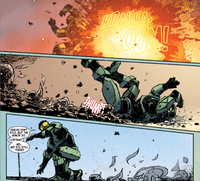
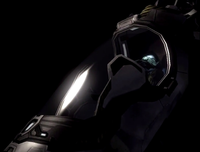


![A full set of Mark V[B], the first version of the Mark V armor to enter service.](https://halo.wiki.gallery/images/thumb/f/f2/Reach_E310_NobleSix.png/64px-Reach_E310_NobleSix.png)






